Toronto loves its sports teams; just head down to the square in front of the Air Canada Centre, or Nathan Phillips Square around playoff time for proof of this. This affinity, though, tends to come with limits. Despite its enthusiasm for sports throughout the rest of the year, Torontonians adopt an attitude towards marathons that is at its best cavalier, and at worst, downright spiteful: in 2009, runners were booed by drivers fed up with road closures; the Sun said that “marathon is actually a four-letter word,” and complained of a “marathon of headaches.” In 2010, the late Rob Ford suggested that marathoners ought to run laps of city parks rather than on Toronto streets, while in 2014 current Mayor John Tory complained that marathons were “creating nightmarish problems” and said (of an event that draws runners from all over the world, brings in millions in economic benefit, and brings people out of their homes and into public spaces with their neighbourhood communities) that “it is time in a big city like this that the public was placed first.” It begs the question: what did marathons ever do to Toronto?
Whereas in cities like New York, Chicago, and London (the crown jewels of the marathon world) marathons are city-wide events that engage runners and non-runners alike, Torontonians tends to view marathons as an inconvenience, something that stands in the way of the city’s functionality. “Toronto’s a running city,” says marathoner Mike Anderson, owner of BlackToe Running, an independent running store at King West and Bathurst. Being a running city, though, extends only to the running community itself in Toronto and, unlike other major cities, has garnered little enthusiasm in the non-running community. “One of the things I find most frustrating is that other cities embrace it,” says Anderson. “It’s a little ridiculous that people [in Toronto] are upset that there’s more traffic at 6am on a Sunday.”
When Anderson, who has lived and ran in Toronto since 1989, ran the New York City Marathon, he remembers crossing a bridge into Manhattan and being greeted by crowds ten to fifteen people deep, cheering so loudly that he could barely hear himself breathe. In comparison, he says, “Toronto’s pretty quiet. For whatever reason, the city’s not behind [the marathon] yet.”
At first glance, it may seem like the pedantic complaints of the running community. But it sits within a larger trend of Toronto’s struggle to conceive of itself as a world-class city (“the city loves to self-flagellate over how it stacks up against the rest of the world,” writes Ashley Csanady in the Post). One metric by which to judge a city, though imprecise, is to look at its marathon. “Every city worthy of the name has to have a marathon,” says Alan Brookes, head of the Canada Running Series and the head organizer of the Scotiabank Toronto Waterfront Marathon. Indeed, a list of the world’s greatest marathons and a list of the world’s greatest city would tend to look nearly identical.
Elitist and niche though they may be, marathons are both tourist attractions and showcases of the city’s urban environment. Unlike other sports, the quality of a marathon depends directly on the environment it takes place in, making a city marathon an event which depends on the urban space and design of a city. Sport — which includes marathons — is a vibrant part of urban life in major cities, and it is significant that Toronto lags behind other world-class cities that have embraced marathons and turned them into cornerstone events in the city’s calendar. The question of marathons is implicitly a question about a city’s relationship with sports within its urban space.
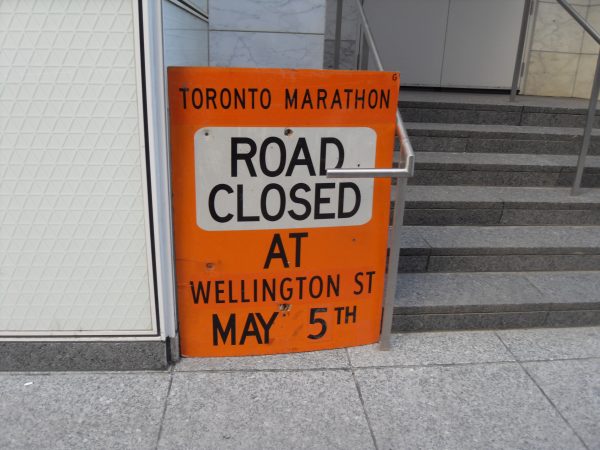
In 2015, Paris Mayor Ann Hidalgo stood at the start line of the Paris Marathon and issued a proclamation that is now famous among marathon enthusiasts and those who work to organize city marathons. “Paris is yours,” she said. “It is the most beautiful city in the world, and you make it more beautiful.”
Mayor Hidalgo’s opening proclamation has come to exemplify, for organizers like Brookes, the ideal attitude towards city marathons. A well-organized and successful city marathon “puts a city on the map,” says Brookes. Over the past decade, marathons have increased dramatically in popularity and participation levels. Between 2005 and 2013, there was a 36% increase in the estimated number of marathon finishers in the US. (Growth has been even more dramatic in developing countries like China, where marathon participation since 2009 has increased by 260%.)
With increased numbers, and an increased demand for courses that highlight a city’s best urban assets, planning the course — which, for many marathons is the biggest point of conflict with city administration, as it blocks traffic and forces road closures — is a balancing act. The big challenge, says Brookes, is “to develop city marathon courses that run through neighbourhoods with character that showcase the city, and where there is a maximum spectator draw — but without antagonizing residents, politicians, and stakeholders.”
Outside of traffic congestion, marathons tend to be beneficial to the city in which they’re held. Beyond the obvious benefits of a “fitter, healthier city” that Brookes says city marathons bring, there is economic and charity benefits as well: the 2015 New York City Marathon brought an estimated $415-million in economic benefit to the city, as well as generating $34.5-million raised for various charities. Even at smaller, lower-profile marathons like the Scotiabank Toronto Waterfront Marathon, the economic benefits are large: Toronto draws in somewhere in the range of $25- to $30-million in economic activity as a result of the marathon.
Despite the benefits, Toronto has had a complicated relationship with marathons — with many, like Anderson, feeling that Torontonians don’t support running events like the marathon. “I’d say the verdict’s out, the jury’s out,” says Brookes, who says that it really comes down to the individual: “If people like festivals and events, then they will help us,” he says. “If they don’t, they’ll hate us.”
But online, Torontonians are quick to voice their distaste for major road races. “Marathons f***ing suck, go run into the lake,” said one Reddit user. “We have more interesting things to do in Toronto than watch people run at a moderate pace in a straight line for a few hours,” said another. One took aim at marathoners themselves, saying “people who run marathons are the same people who make going to high park to see the cherry blossoms a day trip.” The notion that a marathon is a city-wide event seems lost on most Torontonians: “Most of these marathons are for the participants to accomplish, not to cheer for” wrote Reddit user Bobzyurunkle. “Family and friends are the perfect spectator for these, why should strangers do it?”
Ambivalence towards the marathon goes deeper than the grumblings of city residents. Marathons have, on occasion, been matters that have pestered City Hall. Since 2000, two major marathons have been run in the city’s downtown core — the Toronto Marathon (currently sponsored by Goodlife) and the Scotiabank Toronto Waterfront Marathon, first held in 2000. While the Toronto Marathon is older and has traditionally laid claim to being the city’s ‘official’ marathon, since 2005 the Waterfront Marathon has drawn both more runners, more spectators, and has been considered a superior event. (In 2015, the Waterfront Marathon was awarded an IAAF Gold Label, acknowledging that it meets certain athletic standards.)
For over a decade, the two marathons were direct competitors: they ran within three weeks of one another each fall, battling for participants and cultivating a great deal of ill-will among city politicians, right-wing commentators, and frustrated motorists. By 2009, the City was actively trying to find a solution for what they saw as a problem: in January 2010, the city released titled “Establishment of One Toronto Marathon” in which they called for one of the marathons to be scrapped and folded into the other.
Unsurprisingly, neither Jay Glassman, organizer of the Goodlife Toronto Marathon, nor Brookes were willing to give up their race, and both remained recalcitrant to the idea of moving one of the marathons to the spring. (Eventually, under the implicit threat that the city might make the decision on its own, the Goodlife Toronto Marathon agreed to move to the spring.)
The largest source of conflict comes both from the way the city conceives of marathons and a fragmented decision-making process at the city level. Events like marathons are considered extraneous to the day-to-day business of city management — police officers responsible for traffic control and event security are paid-duty, which, though a small distinction is telling: for the City of Toronto, hosting marathons (and events like them) are considered on-the-side events, rather than part of its regular responsibilities.
On top of this, the city lacks a central department responsible for sporting events, which creates conflicts between departments — transit officials, for example, want the marathons run earlier, while those concerned with noise bylaws want marathons to be run closer to the midday. On committees, inter-departmental conflicts can clog the decision making process, and dissuades marathon supporters from fighting for the events: “If I’m a junior member of one of these committees, there’s absolutely no upside to fighting for it,” says Brookes. “All it’s going to get is another department that hates me.”
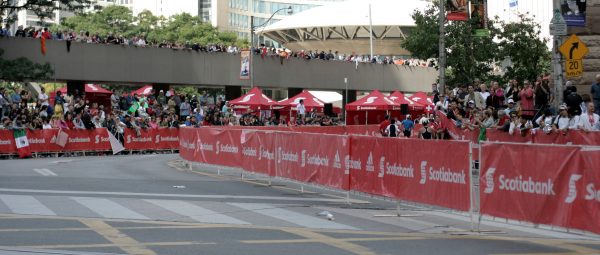
In 2015, The10and3.com named Toronto the second most miserable sports city in North America. For Toronto runners, this attitude seems to extend towards marathons — events that in cities like Chicago, Houston, and Vancouver are attended in large numbers. One metric that is used to judge community support is the estimated number of non-running spectators that come out to watch the race. The Waterfront Marathon, in comparison, draws in just over 100,000 spectators — a number that seems large until you contrast it with comparably cities: despite its downtown population being one quarter of Toronto’s, the Vancouver Marathon draws 92,000 spectators; the Houston Marathon boasts that it draws “a couple hundred thousand spectators” every year; the Chicago Marathon (a city with a similar population to Toronto) boasts an astounding attendance on crammed streets — part of the reason that the Chicago Marathon has been elevated to be considered one of the world’s major city marathons (a group that includes the New York, Boston, London, Berlin, and Tokyo marathons).
Toronto’s reputation when it comes to marathons isn’t great — runners tend to feel that, historically, the city hasn’t done much to foster a welcoming atmosphere for running events, and that community support for running is lacking. Is that still the case? Brookes is optimistic that this attitude is being left in the past. “Thirty years ago, it was true, but not anymore,” he says. “If you’d asked me ten, even five years ago, I’d be less bullish, but we’re really turning a corner.” On paper at least, Brookes is doing much to help change Toronto’s reputation as a poor city for marathons: in addition to the gold label his marathon received in 2015, they have had significant increases in terms of spectator support.
Even so, as the sport of running and interest in marathons grows in Toronto, so too does the discontent. “Marathon racing is growing like crazy,” says Anderson, “but the people who aren’t doing it don’t want that to happen for some reason.” Within certain vocal and outspoken circles of Torontonians, it seems clear that marathons are something to be tolerated rather than enjoyed by the public. “There’s segments who are welcoming, there’s segments who are ambivalent,” says Anderson. “It’s the people who are vocally against it that are the problem.” That problem is intensified when you consider that those circles include Toronto’s last two mayors.
The road closures inherent in organizing a city marathon drew the ire of noted car-enthusiast Rob Ford, who during his 2010 mayoral campaign said, “I think we’re using the roads one too many times, and it’s really frustrating for people trying to get in and out of the city,” and instead proposed that marathons be staged in High Park or Downsview Park (Ford backed off the idea after he was elected, which among marathon organizers and runners alike is a logistical non-starter). John Tory has, more recently, used traffic to justify the idea of reducing the number of road races (all of which are charity fundraisers) saying that he was “willing to take the heat” for saying no. “David Miller once told me that for a major city-wide project and any description to be successful,” says Brooks, “it needs strong central leadership.” Whether or not that strong central leadership exists (as far as marathons are concerned) remains to be seen — organizers like Brookes are still waiting for an “Ann Hidalgo moment” that can take marathons in Toronto from a niche event to something with broad appeal.
There is a certain subset of Toronto residents who are quick to wrap themselves in the flag of ‘war on the car’ — as if such a thing ever existed (and, even if it did, that it would at all be a bad thing.). The way Torontonians have interacted with both the concept and physical realities of marathons being run on city streets betrays a larger degree of apathy towards large-scale community engagement. What’s more troubling is that this apathy, reflected in vitriolic debates about bike lanes and condo development and low-income housing, seems more and more like Toronto’s default setting.
When drivers complain that they are inconvenienced by race-related road closures, they fail to realize that having one trip obstructed is the implicit trade-off with a community of runners who generally work around them on the other 364 days of the years (some early morning runners, for example, do so largely for the benefit of decreased traffic at 5:30am). I’ll admit that there’s a bit of self-interest at play here: even if few people understand the realities of training for a marathon, when (if all goes to plan) I run the Waterfront Marathon this fall, I don’t think it’s even remotely too much to ask that I don’t get booed. For runners, after a year of dodging cars, waiting for traffic, and running in parks and along bike paths, it would be nice that for three and a half hours on a Sunday morning in October, that the roads — as they are in Paris, as they are in Boston, and as they are in New York — were ours.

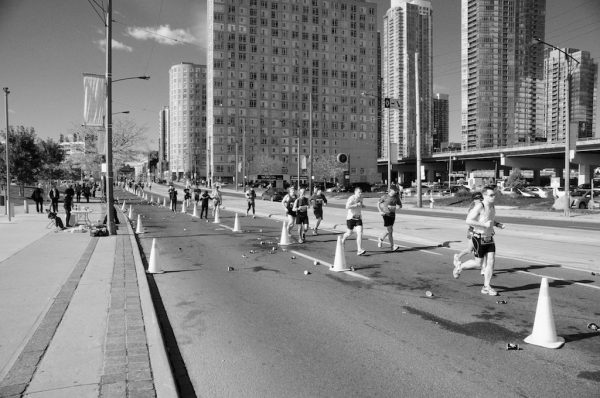
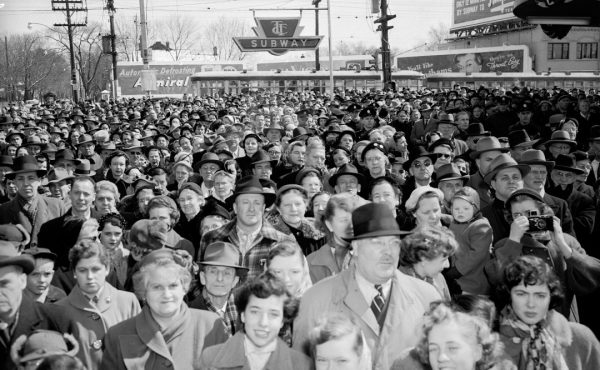
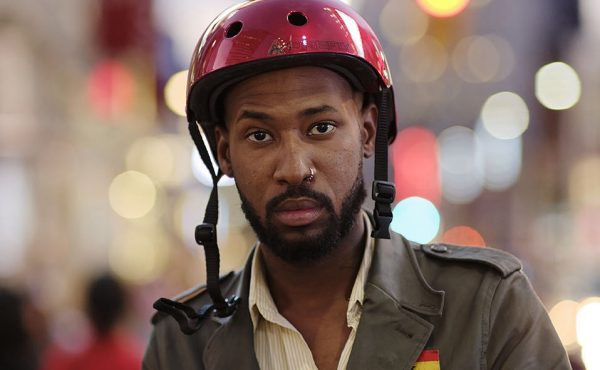
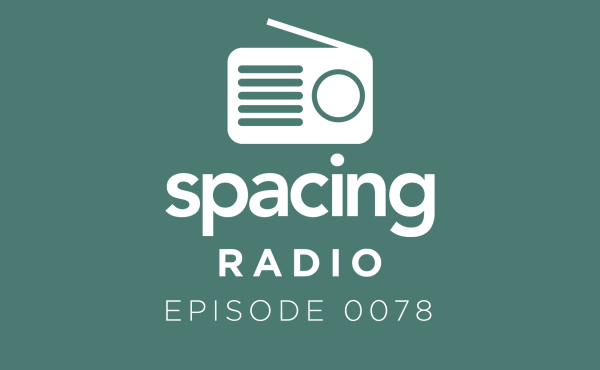
15 comments
Interesting article, but needs to be cleaned up. There are a few puzzling blanks, such as:
” the Waterfront Marathon was , acknowledging that it meets certain athletic standards.”
or
“despite its downtown population being one quarter of Toronto’s, the Vancouver Marathon draws ;”
Somewhat counterintuitively, I think part of the problem with marathon scheduling is that they’re scheduled for times when traffic is supposed to be low. But that means they’re also scheduled at times when TTC service blows. It’s probably somewhat better now with the 8am subway openings than it was with 9am ones but my past experience has been that it’s impossible to get anywhere downtown during the Toronto marathon if you had to be there before the subways started running. There’s a conference I have often attended on the same weekend as the fall marathon, and getting there for a 9am start time has always been basically impossible — you can’t drive into the area because of road closures and the traffic disaster that surrounds them, you can’t subway into the area, because no subways.
I suspect this may also be part of why we don’t turn out in droves to watch these things. If you can’t get there without a massive hassle, why would you?
Part of the issue Toronto has is the Ottawa marathon be it runners or people who just want to watch its seen as a great event take runner you have a choice Ottawa or Toronto most pick Ottawa.
Interesting article.
It would be nice if we could discuss the impact on marathons and other road races (the Yonge Street 10K disrupts traffic as well) on transit and getting around downtown on foot and by bike. The Yonge Street 10K disrupted nearly every east-west streetcar line in Toronto, from St. Clair to King Street. Cyclists are often prevented from getting across the Richmond and Adelaide bike routes while pedestrians are often shoved into the PATH system to get around the barricades. The new 8AM opening of the Subway helps, but the marathons and 10K runs start sooner than that.
I liked what the Spring Toronto Marathon did for its route – use Rosedale Valley Road and the Bayview Avenue Extension, which allowed for a north-south route that had limited impact on surface transit. As far as I’m concerned, motorists can suck it up for three or four Sunday mornings a year, but I would like to see, somehow, a better solution for the rest of us.
The issue here is not just the one Marthon that we should all be patient about. As someone else points out there are other races , then the DVP is closed for something else, then the major arteries like DVP, QEW and Gardiner closed for road repairs , then subways being closed for maintenance every week-end and many of these closures seem to not to be synchronized with major professional ball games or events downtown. And getting around during these times is a nite mare. Police never available when you need them to direct traffic so we’re left to our own devices and temperaments. Do other major North American cities really close the major arteries so often for so many of these events?
I’ve often heard runners talk about the contrast between Toronto’s attitude and the enthusiastic support other cities give – it’s good to have the issue laid out clearly like this.
We have 3-5 marathons, 10k, 5k, run, walk and roll (wheelchair) across the GTA every weekend from March to November. It would be more feasible to just build a venue for them to run laps and even dedicate a TV channel for it.
My biggest problem with these runs is that they are unjustly attached to charities. What is running have to do with charities? Running is not a service anyone require, isn’t it? Can any one of them honestly say that the amount of time spent training and money spent on running gear isn’t far more than the amount they’ve raised? Training for marathon is at least a 1000 hour job. How many of them raised $15,000 per year? If you truly want to raise money for a cause, wouldn’t your time be better spent on doing a temp job?
I mean, how would you feel if they started blocking traffic for Comic Con every weekend to raise money for Sick Kids Hospital? If you say anything bad about that guy who dressed like Chewbacca, people would call you children-hating. You know what, Chewbacca would have dressed like that with or without Sick Kids.
So yes, I don’t like that they block traffic for marathons. It is bad for local business. I don’t see why you can’t just run laps. But I’m tolerating them because they are hiding behind charities, and the illusion that it is healthy.
Could this whole thing just a porta-potty industry conspiracy? Porta-potty illuminati?
It should, however, be acknowledged that those drivers have paid the lion’s share of the via licensing and gas taxes to build and maintain the roads that get closed. It is not a simple matter of suck it up.
KJ — that’s not true. It’s split between everyone. There was a time 25 years ago when some stuff was paid straight from the revenue of the license renewals, but that’s no longer the case. And the gas tax gets put into the general revenue pot and used for whatever the government at the time wants.
It’s also a poor line of argument to take: you can take lots of infrastructure projects and say “X” paid for this so “X” deserves this more. That’s not how our system works — we share infrastructure despite who pays for it.
“One metric by which to judge a city, though imprecise, is to look at its marathon. “Every city worthy of the name has to have a marathon””
Really? Since when is having a marathon any indication of world class status?
I do like the idea of the Mayor’s office having a single liaison for putting together big events. Especially someone dedicated to sports and civic boosterism. I think it would be a lot less problematic if bureaucrats knew the person whose head would be on the platter if things went wrong, and someone was looking at a calendar (and map) coordinating all this.
What’s Pinball Clemons up to these days?
Full disclosure – both Toronto Marathons are clients of mine.
What is not known and this story does not address, is the absolutely extraordinary lengths both organizations go to to inform and tell people that the races/events are going on. It’s a full-on, massive amount of work, multi-faceted, omni-channel operation that they do to get the word out! Yet, many Torontonians are oblivious* and completely unaware.
Knowing what the race organizations do on this front, you’d have to be living under a rock, in the far back corner of a cave to NOT know that the marathon(s) are going on – yet there are the masses stuck in traffic or behind a barricade shaking their fists at the sky, the police, and the runners on race day! And for the knowing – if you know the marathon is on, why would you even think about bringing your car into the city? Do you like self-punishment and wasting massive amounts of time?
Why not as other true world class cities do, embrace the race/event, and come out and support it like they do in NYC, Paris, Boston, London etc . . . ?
*If there is a world-wide index for Obliviousness – that’s definitely something that Toronto is a World Leader in! 🙂
Toronto has done more than “well” in the last 20 years to become a great, world class city, despite us not having a race of 26.2 miles comparable to cities like New York or Chicago……Tourism is at record levels…..overall you have to measure the other festivals (film), movie shoot business, sports teams (win or not, they draw tourists)…….restaurants, bars, patios…….in the next 20 years Toronto will improve as long as transit improves……so I disagree that one event will make a difference….
“I don’t see why you just can’t run laps.”
Well, technically you could, but no-one would want to run that course, and so you’d lose out on the benefits of a big-city marathon (and there are benefits – the World Majors generate millions of tourism dollars for their host cities, plus the prestige & international promotion factor).
The TCS New York City Marathon is the largest in the world, with over 50,000 runners, but when it started it just did laps of Central Park and had fewer than 100 participants. It grew every year, but it wasn’t until they changed the course to encompass all 5 boroughs that it really started to grow by leaps and bounds into the juggernaut that it is today. (Amusingly, per Wikipedia, it wasn’t the race director’s idea to change the route – it was the City auditor. So there are people outside of runners who see the benefit of these things.) A big part of the draw is being able to run the streets and see the city from a very different perspective.
Not to get too cornball about it, but it honestly feels like you’re seeing a city at its best at these big events. Running the Chicago marathon, passing through the Loop and Boys’ Town and Little Italy and Chinatown and Pilsen, seeing a million people on the streets, cheering but also just using the event as an excuse for a day-long, 26-mile street party – it becomes, at best, a celebration not just of the sport but of the city. I’d love to have that here.
I won’t deny it’s inconvenient for many (especially so, since we’ve underinvested in transit for decades), but living in a world capital involves trade-offs. For every cultural event you love there’s ten you don’t care about that you wish would get out of the way of the streetcar; for every sporting event you’re passionate about there’s ten you think are a dumb pain in the ass. Living in a city has many positives, but it’s possible the biggest one is disguised as a negative: learning to live closely with people who are not like you. So the roads are blocked off by a bunch of sweaty ectomorphs and you can’t drive anywhere for a couple hours. It’s Sunday morning and nothing’s open anyway. Why not just join the party?
I love this article. There is a marked difference in support and enthusiasm in Toronto vs. other major cities, like Ottawa or New York. Toronto needs a culture shift to embrace the runners! 🙂